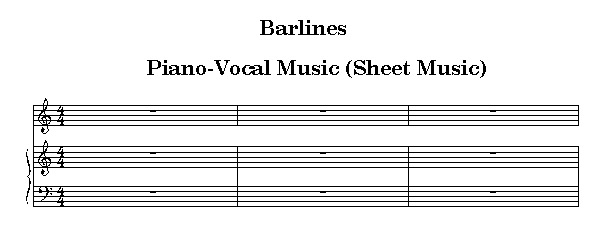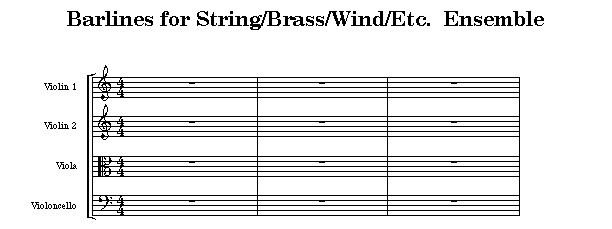Thickness
The only fixed standard is that generally barlines are the thickest, staff lines are thinner, and stem lines are the thinnest. Barline thickness varies from engraver to engraver.
Length
Length depends on the Type of Score:
Note: All barlines are vertically aligned within a system, whether they are connected or not.
- Single-line music: The barline connects the top and bottom lines of the staff.
- Piano: A systemic barline, which connects the beginning of two or more staves, is used. Then the connecting barlines continue throughout the piece.
- Vocal-piano (sheet-music):A systemic barliine connects the 3 staves. Then the barlines for the piano part are connected, and the vocal part is treated like single-line music.
- Vocal ensemble: A systemic barline is used at the beginning of the piece, then the barlines for each staff are separate.
- Vocal Ensemble with Piano: A systematic barline connects all the staves. Then the vocal barlines are separate for each vocal part, but the piano barlines are connected.
- Organ: A systemic barline connects all 3 staves. Then only the first 2 staves are connected (the manual staves and stops), and the pedal staff has a separate barline.
- Full Band/Orchestra: A systemic barline connects all staves. Then connecting barlines are used for each section: brass, strings, etc.
- Condensed Band/Orchestra: A systemic barline connects all staves. Then barlines connect all staves, except for the percussion part, which has a separate barline after the beginning systemic barline.
- String/Brass/Wind and other Instrumental Ensembles: A systemic barline connects all staves. Then connecting barlines are used on all staves.
Double Barlines
- Length is determind the same way as with single barlines.
- Mark the end of a section of music, and usually precede a key or meter change.
- The 2 lines should be approx. 3/4 space apart (12 EVPU’s).




Leave a Reply